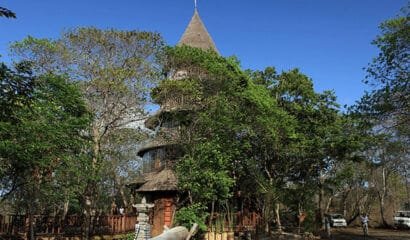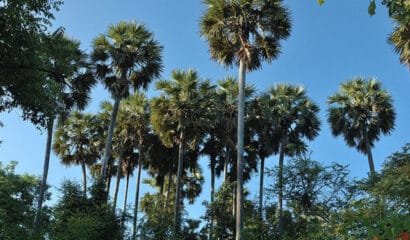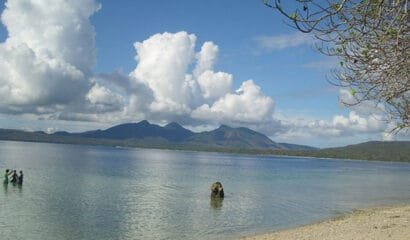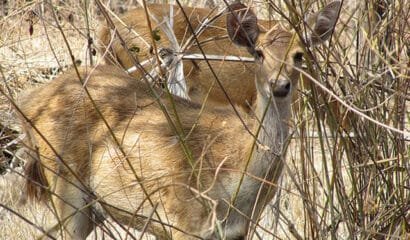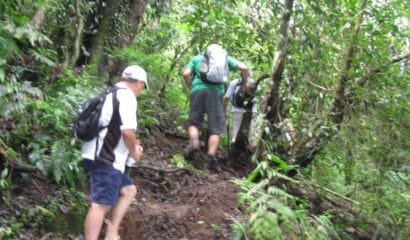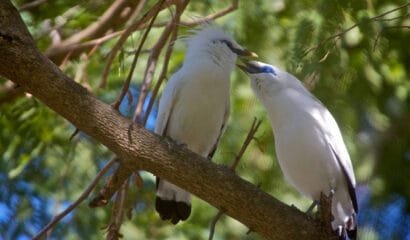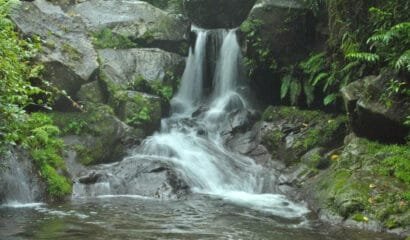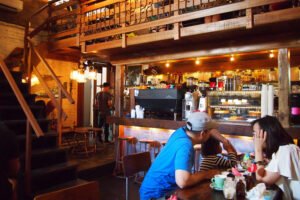The north western area of Bali encompasses the West Bali National Park (Taman Nasional Bali Barat) and is a wilderness treasure comprising 25.800 hectares (63.700 acres) of rain forest, palm, mangroves and a wide variety of indigenous and non-indigenous flora and fauna. The area is protected and is the key destination for those interested in nature conservation and hiking. The Park was opened in 1984 and the headquarters are located at Cekik on the west coast.
The lands in this region are said to be the home of the Pulaki people, who were mythically “banished” and made invisible by the god Indra. Historically, an area of 200 square kilometres of coastal forest around the Prapat Agung peninsula in the northwestern tip of Bali was designated as a Nature Park to preserve the endangered Bali Tiger. Unfortunately it was too late and the Bali Tiger then became extinct. The park was extended in 1974 and again in 1985 when a further 500 square kilometres of interior forest was included and the surrounding area was upgraded to become the Bali Barat National Park as it is known today.
This remote wilderness is now home to the endangered Bali Starling (Leucopsar rothschildi), a small white bird with brilliant blue streaks around its eyes and black tipped wings. A cooperative conservation program has been implemented by Indonesian and overseas agencies to introduce birds from various breeding programs back into the wild. As Bali’s closest neighbor to Java, the park is also inhabited by a variety of indigenous migratory bird species which cross the Bali Strait from Java. The Black Shouldered-Kite, the Yellow Billed-Oxpecken, the Blue Kingfisher the White-Bellied Sea Eagle are among a few of the birds that can be found in the Park.[/vc_column_text][vc_empty_space][dt_small_photos category=”bali-national-park”][vc_empty_space][/vc_column][/vc_row][vc_row][vc_column][vc_column_text]Park Flora & Fauna
The Park has many animal species. You will find deer, civet, monkeys and the wild Javan buffalo (bos javanicus). Other fauna include the Ant-Eater (Manis Javanicus) , Porcopine (Hystrix Branchyora) , Leopard Cat (Felis Bengalencus) , Barking Deer (Mantiacus Muntjak), Black Monkey (Presbytis Cristata) and Giant Squirrel (Ratufa Bicolar).
Flora include Lontar Palm (Bonasus Flabellfer), Sawo Kecik (Manilkara Kauki), Keruing Bunga (Dipterocarpus Hasseltii), Sono Keling (Dalbergia Intifolia), Cendana (Santalum Ulbum), Pulai (Alstonia Scholaris), Kepuh (Sterculia Foetida), Kemiri (Alcuritas Moluccana), Trengguli (Cassia Fistula), Bayur (Pterospermum Diversifolium), Buni (Antidesma Bunius), Bungur (Logerstromia Speciosa), Burahol (Stelechocarpus Burahol), Kesambi (Scheichera Oleosa), Mundu (Garcia Dulcis).
Much of the terrain in the Park and surrounds is monsoon forest and coastal savanna. The region is characterised by a smaller annual rainfall that the average in Bali. During the dry season (June to September) there is sparse rainfall and the trees shed their leaves, leaving the landscape scorched and yellow. When the monsoon rains fall in December, the entire landscape is magically transformed and becomes lush and green again.
Park Hiking
Exploring the West Bali Nature Park is a unique experience and a wonderful way to discover more about Bali and its diverse natural environment. Depending on your physical capacity, park-trekking with an experienced guide can be arranged for two up to five hours duration.
Hiking is welcome in the park, and a free permit needs to be obtained from the Parks Headquarters at Cekik, or from the Department of Forestry on Jalan Suwung in Denpasar prior to entering the Park.
Visitors intending to hike through the Park will need to note there are limited medical services or other facilities to cater for foreign visitors. Overnight stays are available, with all necessities such as bedding, utensils, food and water provided by the visitor. Basic cooking equipment can be rented from the Park. It is best to inform park authorities in advance if you plan to stay overnight so they can prepare facilities and make sure guides are available. Day trips are also available, with simple accommodation available in nearby Labuan Lalang.
An afternoon exploring the heart of the Bali Barat National Park (along the western coast of Prapat Agung peninsula) is a fascinating opportunity as Prapat Agung is home to many varieties of Bali Barat species, making this peninsula the main zone for Park conservation. There are several species of vertebrates such as kera hitam (black monkey / Presbytis cristata), kera abu (macaque monkey), menjangan (barking deer / Cervus timorensis), kancil (Trangulus javanicus), babi hutan (wild pig) and kucing hutan (wild cat).
Reptile biawak (giant lizard / Varanus salvador) and Aves ayam-hutan hijau (green jungle fowl / Gallus varius), eagle and owl can also be found in this area. Several endangered plants include sawo kecik (Manilkara kauki), panggal buaya and cendana (Santalum album).
From Labuan Lalang it is possible to hire boats and snorkelling equipment to explore nearby Pulau Menjangan, “Deer Island”, where coral reefs extend to the ocean floor. Diving (you will need your own equipment), snorkelling and swimming are the main activities, and hiking around the island to find the elusive deer.
Park Trekking
The terrain and landscape of the Bali Barat National Park largely consists of monsoon forest and savanna. Lush mangrove vegetation also occupy some of its coastal area along the bay of Banyuwedang and Gilimanuk, Prapat Agung peninsula and Menjangan Island.
Characterized by small annual rainfall, much less from the rest of Bali particularly the south, the Park deserves distinct nature both in flora and fauna. To explore its unique terrain and wildlife, trekking inside the Park can truly be a discovery. Depending on physical capacity, we arrange park-trekking ranging from two up to five hours.
Specialist Tour – Park Safari
To ensure the best opportunity to observe and to be informed on the Park’s natural habitat, this safari tour is exclusively organized by Park approved guides and is only available during the dry season (from June to October), from 03:00 pm until approximately 06:00 pm to avoid the midday heat. This provides the best opportunity as many of the animals/fauna approach the coastline during the dry season and move deeper into the Park during the wet season (from November to April). The safari tour is arranged by car and departs from a collection point in Tegal Bunder; a Ranger Post near the breeding centre for the endangered Bali Starling.
Commence your adventure here through the network of unpaved roads leading along the western coastline of the peninsula. The last stop on the journey is Lampu Merah, another Ranger Post opposite the ferry harbor of Gilimanuk and the East Java coast. The safari tour takes around 1.5 to 2 hours, traveling along 12 kms of track. You will be escorted back to the hotel/resort along the same road, as this is the only available returning access available by car.
Specialist Tour – Bird Watching
The Bali Barat National Park is the preferred habitat of approximately 300 species of tropical birds, both migratory and endemic. Many of them are quite difficult to spot. From seed, insect and fish-eating species, all can be found here either within the monsoon rainforest habitat or along the coastal mangrove swamp network.
For a more advanced birding, we arrange guided tours into several birding sites across the Park. To ensure the best opportunity to observe the birds within the Park, tours are arranged for t-either morning (7:00 to 9:00 am) or late in the afternoon (4:00 to 6:00 pm). Depending on the current season and the weather, birding-site options include the coastal mangrove area of Teluk Terima including a small nearby river, Tegal Bunder near the Starling rehabilitation centre and the coastal areas of Cekik close to the Park Headquarters.
Specialist Tour – Bali Starling Visit
The Bali Barat National Park is home to an endemic bird area (EBA) for the Rothschild’s Mynah which is more commonly known as the indigenous Bali Starling. The bird is pure white except for its black wing-tips and blue face. In the evenings, the mynahs fly down from the hills where they feed during the day to roost near the sea. The local Pilang tree (Acacia leucophloea) which occupies many parts of the monsoon forest is the prime nesting site for the Bali Starling. This is because the tree sheds its bark as it matures, making it slippery for predators such as snakes to hunt the starling eggs.
There are currently two rehabilitation centres in the Park. One is located in Tegal Bunder just at the gate to Perapat Agung peninsula, and another is in Teluk Berumbun, opposite Menjangan Island. Tegal Bunder is the first rehabilitation stage where the captive birds are intensively bred to be introduced back to wild before finally being pre-released in Teluk Berumbun.
If you are interested to know more about the Bali Starling Breeding Program and other conservation initiatives, a visit to the Rehabilitation Centre in Tegal Bunder can be arranged.


